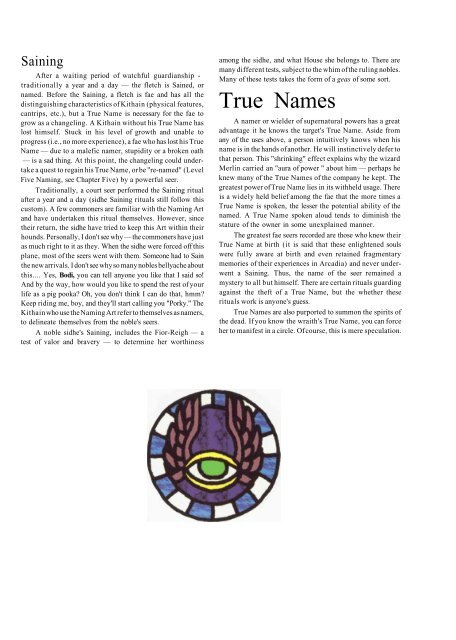Changeling - Players Guide.pdf
Changeling - Players Guide.pdf
Changeling - Players Guide.pdf
Create successful ePaper yourself
Turn your PDF publications into a flip-book with our unique Google optimized e-Paper software.
Saining<br />
After a waiting period of watchful guardianship -<br />
traditionally a year and a day — the fletch is Sained, or<br />
named. Before the Saining, a fletch is fae and has all the<br />
distinguishing characteristics of Kithain (physical features,<br />
cantrips, etc.), but a True Name is necessary for the fae to<br />
grow as a changeling. A Kithain without his True Name has<br />
lost himself. Stuck in his level of growth and unable to<br />
progress (i.e., no more experience), a fae who has lost his True<br />
Name — due to a malefic namer, stupidity or a broken oath<br />
— is a sad thing. At this point, the changeling could undertake<br />
a quest to regain his True Name, or be "re-named" (Level<br />
Five Naming, see Chapter Five) by a powerful seer.<br />
Traditionally, a court seer performed the Saining ritual<br />
after a year and a day (sidhe Saining rituals still follow this<br />
custom). A few commoners are familiar with the Naming Art<br />
and have undertaken this ritual themselves. However, since<br />
their return, the sidhe have tried to keep this Art within their<br />
hounds. Personally, I don't see why — the commoners have just<br />
as much right to it as they. When the sidhe were forced off this<br />
plane, most of the seers went with them. Someone had to Sain<br />
the new arrivals. I don't see why so many nobles bellyache about<br />
this.... Yes, Bodi, you can tell anyone you like that I said so!<br />
And by the way, how would you like to spend the rest of your<br />
life as a pig pooka? Oh, you don't think I can do that, hmm?<br />
Keep riding me, boy, and they'll start calling you "Porky." The<br />
Kithain who use the Naming Art refer to themselves as namers,<br />
to delineate themselves from the noble's seers.<br />
A noble sidhe's Saining, includes the Fior-Reigh — a<br />
test of valor and bravery — to determine her worthiness<br />
among the sidhe, and what House she belongs to. There are<br />
many different tests, subject to the whim of the ruling nobles.<br />
Many of these tests takes the form of a geas of some sort.<br />
True Names<br />
A namer or wielder of supernatural powers has a great<br />
advantage it he knows the target's True Name. Aside from<br />
any of the uses above, a person intuitively knows when his<br />
name is in the hands of another. He will instinctively defer to<br />
that person. This "shrinking" effect explains why the wizard<br />
Merlin carried an "aura of power " about him — perhaps he<br />
knew many of the True Names of the company he kept. The<br />
greatest power of True Name lies in its withheld usage. There<br />
is a widely held belief among the fae that the more times a<br />
True Name is spoken, the lesser the potential ability of the<br />
named. A True Name spoken aloud tends to diminish the<br />
stature of the owner in some unexplained manner.<br />
The greatest fae seers recorded are those who knew their<br />
True Name at birth (it is said that these enlightened souls<br />
were fully aware at birth and even retained fragmentary<br />
memories of their experiences in Arcadia) and never underwent<br />
a Saining. Thus, the name of the seer remained a<br />
mystery to all but himself. There are certain rituals guarding<br />
against the theft of a True Name, but the whether these<br />
rituals work is anyone's guess.<br />
True Names are also purported to summon the spirits of<br />
the dead. If you know the wraith's True Name, you can force<br />
her to manifest in a circle. Of course, this is mere speculation.


